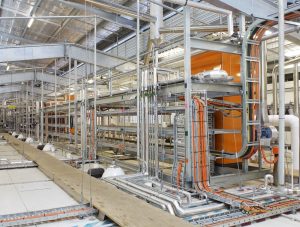
- Industry Type: Industrial Manufacturing, Food Processing
- Author: Martin Bevis
- Service Area: Advice, Design, Engineering
- Date:

A Heated History
The principle of using heat treatment, or pasteurisation, as a means of killing harmful microbes was established by Louis Pasteur in 1862.
The principle has changed little since then and is in universal use throughout the food industry as a vital part of the food safety chain.
But consumer expectations have changed with a shift in choice away from processed food where the original taste, texture and olfactory sensations have become dulled or degraded by excessive heat treatment, toward more natural products where the flavour, colour, and nutritional benefits of the original raw product are mostly retained. This shift, coupled with an ever increasing awareness of the health benefits of more natural food, means consumers are now prepared to pay a premium for a product that delivers higher quality.
In response to this demand, heat treatment methods have evolved, and many manufacturers now pasteurise for shorter time periods but at higher temperatures to reduce the degrading effect on the food properties. The endpoint of this evolution is nearing though, as there is only so far pasteurisation times can be reduced before the process ceases to be reliable and effective.
Putting on the Pressure
There is a number of existing and developing technologies proving to be just as successful at maintaining food safety, while producing a superior product when compared to the results of traditional pasteurisation.
High Pressure Pasturisation (HPP)
Currently in use commercially, HPP is the most well-known of these alternative technologies and there are several Australian companies, as well as one in New Zealand, exploiting its benefits.
HPP is a batch based process using extremely high pressures of between 400 and 600 MPa. This pressure is exerted on the product in a special chamber, to break down the harmful bacteria in the product. This pressure energy produces a small temperature rise in the product, but this is not enough to affect its properties.
HPP does have its limitations, as C Botulinum and some other harmful microbes are pressure resistant. If these are known to be present, then HPP has to be used in conjunction with another barrier process, typically heat. This is a short heat treatment process that is less invasive than thermal treatment alone.
Suitable products for the HPP treatment must contain moisture, but cannot contain any air, e.g. a strawberry; as such items will be crushed by the pressure. The product can be containerised as the pressure is evenly applied both inside and outside the packaging, and so it will not rupture provided there is negligible air inside.
Despite the disadvantage of its batch based operation (which renders it slower than continuous production methods) along with very high start-up costs—HPP is being touted as the next breakthrough in ready meals pasteurisation for example.

Image property of Hiperbaric High Pressure Processing
Ultra High Pressure Homogenisation (UHPH)
UHPH technology, currently limited to liquid products, also relies on high pressure and is particularly suited to the dairy industry as it combines sterilisation with homogenisation, although is still applicable for vegetable or fruit juices.
In this process the product is heated to 75°C and pumped up to a pressure of around 400MPa before it is forced through a special homogenising nozzle. The treatment may require several passes through more nozzles to be effective. The bacteria are destroyed by a combination of the high shear forces and the opposite effect of the sudden pressure reduction when the fluid has passed through the nozzle.
This technology is presently still under development, and is not yet commercially available.
There are also two other further technologies, both of which have commercially available processing equipment. One of these uses high voltage electrical pulses, called Pulsed Electrical Field (PEF) and the other is high intensity Pulsed UV light (PUV).

Diagram property of Degruyter
Pulsed Electrical Field (PEF)
PEF was invented over 20 years ago, though its effectiveness was limited by the technology of that time which was not able to produce the ideal square profile power pulse, and rapid polarity switching, the combination of which makes this method so effective now.
In this process the product is pumped through a tube and is subjected to a series of high frequency, high voltage electrical pulses whilst in the tube for only a few microseconds of exposure. The high voltage field created, of approx. 80KV per centimetre and the rapidly changing polarity are sufficient to break down even the toughest bacteria. The change in polarity stretches the microbe membrane one way, and then the other, and so on, at very high speed until the membrane ruptures.
PEF treatment is only applicable to still liquid products such as fruit juices, yogurts and milk, but not those with entrained air or bubbles. These products require additional high pressure conditions to compress the bubbles to make the PEF effective.
PEF cannot break down spores or dehydrated cells as they do not actually have a cell membrane, and so refrigeration is still required to retain the claimed shelf life of up to 21 days. The treated product will rise in temperature by up to 35°C due to the electrical energy and an inline cooler is often required afterwards to remove this heat.
The overall benefit is a continuous production process with a low energy input where the products original properties are almost unaffected by the treatment. PEF was approved by the United States FDA in 2005 for use in food sterilisation applications.
Versions of this process providing commercially sized production lines are manufactured by Coolwave Technology under the Pure Pulse brand, and Diversified Technologies Inc. These are mainly marketed towards, and presently in use in, the fruit juice market. However, the SMARTMILK consortium in the EU have recently completed a two year study on the use of PEF for processing milk and yogurt. The consortium was made up of small and medium producers, although Arla Foods, a major European dairy producer was also involved. The study endorsed the success of the process and highlighted some points of improvement notably the retention of lacto proteins by use of the PEF method.
The recently improved PEF is an emerging technology which is also finding applications in waste water treatment where it is used to destroy harmful microbes, and also in juice or oil extraction processes where the cells of the raw material are broken down by the PEF, to aid the extraction. So its application is potentially widespread.

Breakdown of the cell membrane due to exposure to electric field and rapid polarity changes.
Pulsed UV Light (PUV)
PUV utilises the principle that strong UV light will disrupt the DNA of the microbes; the pulsing effect provides the sudden burst of high power necessary to achieve an effective kill. Its use is presently limited to the sterilisation of packaging materials such as water and fruit juice bottles and their screw caps, and for clear pharmaceutical containers. Trials are still underway for surface treatment of vegetables and fruit. The UV Light is pulsed several times a second, for durations of typically 100 nano seconds, and as a result is considered to be more effective than continuous Mercury lamp UV systems. It was approved by the US FDA in 2000 as a safe means for pasteurising fruit juices. It will provide an effective kill against bacteria, yeast, moulds and viruses. However, it cannot be used to destroy CJD as this is a prion, and has no DNA. Commercial units are manufactured by Xenoncorp in the USA and Claranor in France.

The PUV can also be used to enhance nutrition. The Australian Mushroom Growers Association have acknowledged an application of this technology to irradiate mass produced mushrooms which normally contain no Vitamin D as they are grown in the dark. The PUV process activates a chemical reaction in the mushrooms which produces significant levels of Vitamin D.
This is of particular interest to Australians and to vegetarians alike, as a large percentage of Australians are known to be Vitamin D deficient, and for vegetarians, it is the only potential natural source of Vitamin D available to them from a non-animal product.
Conclusion
Thermally based food pasteurisation is a very reliable and time tested method of food sterilisation, but products processed in this traditional way may struggle to meet consumers shifting desire for more natural, less processed alternatives.
The road forward for food manufacturers looking to make a point of difference with their products could be in embracing some of these non-thermal sterilisation and preservation methods. Those manufacturers willing to explore any means to take quality to the next level will reap the benefits of producing a superior product with a justifiably higher price point.
These consumer trends and the appropriate new technologies and processes are important to Wiley as we are passionate about keeping our Clients informed and delivering to them the very best and latest the industry has to offer.

Download to read full article
To read this document you will need Adobe Reader


